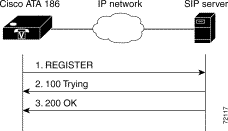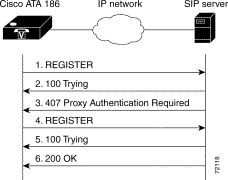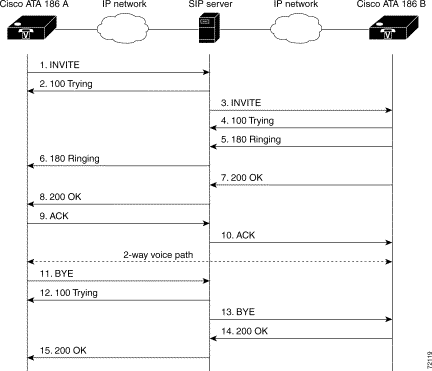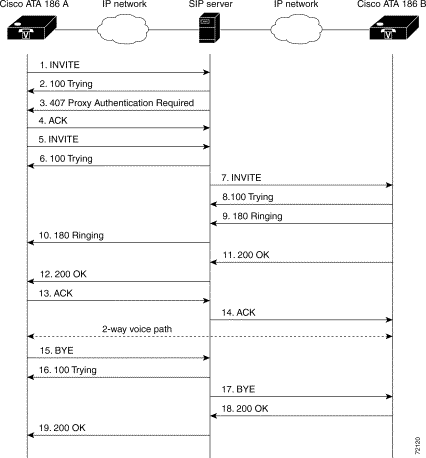
Table of Contents
SIP Call Flows
Supported SIP Request Methods
Call Flow Scenarios for Successful Calls
SIP Call Flows
This section describes some basic call flows for the Cisco ATA:
Supported SIP Request Methods
The Cisco ATA supports the following SIP request methods:
- INVITE—Indicates a user or service is being invited to participate in a call session.
- ACK—Confirms that the client has received a final response to an INVITE request.
- BYE—Terminates a call and can be sent by either the caller or the callee.
- CANCEL—Cancels any pending searches but does not terminate a call that has already been accepted.
- REGISTER—Registers the address listed in the To header field with a SIP proxy.
- NOTIFY—Notifies the user of the status of a transfer using REFER. Also used for remote reset.
- OPTIONS
The following types of responses are used by SIP and generated by the Cisco SIP gateway:
- SIP 1xx—Informational responses
- SIP 2xx—Successful responses
- SIP 3xx—Redirection responses
- SIP 4xx—Client Failure responses
- SIP 5xx—Server Failure responses
- SIP 6xx—Global Failure responses
Call Flow Scenarios for Successful Calls
This section describes call flows for the following scenarios:
Each of the call flows includes a call diagram, action descriptions table, and a sample log file.
Cisco ATA-to-SIP Server—Registration without Authentication
Figure D-1 illustrates the Cisco ATA registering with the SIP server. Authentication is not required for registration.
The call flow is as follows:
1. Cisco ATA requests registration.
2. Registration is completed.
Figure D-1 Cisco ATA-to-SIP Server—Registration without Authentication

Table D-1 Action Descriptions
|
Step
|
Action
|
Description
|
| Step 1
|
REGISTER—Cisco ATA to SIP server
|
Cisco ATA sends a REGISTER message to the SIP server to register the address in the To header field.
|
| Step 2
|
100 Trying—SIP Server to Cisco ATA
|
SIP server returns a 100 Trying message, indicating that the REGISTER request has been received.
|
| Step 3
|
200 OK—SIP server to Cisco ATA
|
SIP server returns a final 200 OK response, confirming that registration is complete.
|
Table D-2 Log Listings
| 1.
|
REGISTER sip:192.168.2.97 SIP/2.0 Via: SIP/2.0/UDP 192.168.2.194 From: <sip:9301@192.168.2.97;user=phone> To: <sip:9301@192.168.2.97;user=phone> Call-ID: 88397253@192.168.2.194 CSeq: 1 REGISTER Contact: <sip:9301@192.168.2.194;user=phone;transport=udp>;expires=3600 User-Agent; Cisco ATA v2.10 ata186 (0705a) Content-Length: 0
|
| 2.
|
SIP/2.0 100 Trying Via: SIP/2.0/UDP 192.168.2.194 Call-ID: 88397253@192.168.2.194 From: <sip:9301@192.168.2.97;user=phone> To: <sip:9301@192.168.2.97;user=phone> CSeq: 1 REGISTER Content-Length: 0
|
| 3.
|
SIP/2.0 200 OK Via: SIP/2.0/UDP 192.168.2.194 Call-ID: 88397253@192.168.2.194 From: <sip:9301@192.168.2.97;user=phone> To: <sip:9301@192.168.2.97;user=phone> CSeq: 1 REGISTER Contact: <sip:9301@192.168.2.194;user=phone;transport=udp>;expires="tue, 23 Oct 2001 14:24:57 GMT" Expires: 3600 Content-Length: 0
|
Cisco ATA-to-SIP Server—Registration with Authentication
Figure D-2 illustrates the Cisco ATA registering with the SIP server. Authentication is required for registration.
The call flow is as follows:
1. Cisco ATA requests registration.
2. SIP server requests authentication credential.
3. Authentication is received and registration is completed.
Figure D-2 Cisco ATA-to-SIP Server—Registration with Authentication

Table D-3
|
Step
|
Action
|
Description
|
| Step 1
|
REGISTER—Cisco ATA to SIP server
|
Cisco ATA sends a REGISTER message to the SIP server to register the address in the To header field.
|
| Step 2
|
100 Trying—SIP server to Cisco ATA
|
SIP server returns a 100 trying message, indicating that the REGISTER request has been received.
|
| Step 3
|
407 Proxy authentication required— SIP server to Cisco ATA
|
SIP server returns a request for authentication.
|
| Step 4
|
REGISTER—Cisco ATA to SIP server
|
Cisco ATA attempts to register using its authentication credential.
|
| Step 5
|
100 Trying—SIP server to Cisco ATA
|
SIP server returns a 100 trying message, indicating that the new REGISTER request has been received.
|
| Step 6
|
200 OK—SIP server to Cisco ATA
|
SIP server returns a final 200 OK response, confirming that the authentication credential has been verified and registration is complete.
|
Action Descriptions
Table D-4 Log Listings
| 1.
|
REGISTER sip:192.168.2.81 SIP/2.0 Via: SIP/2.0/UDP 192.168.2.194 From: <sip:9301@192.168.2.81;user=phone> To: <sip:9301@192.168.2.81;user=phone> Call-ID: 311316842@192.168.2.194 CSeq: 1 REGISTER Contact: <sip:9301@192.168.2.194;user=phone;transport=udp>;expires=3600 User-Agent; Cisco ATA v2.10 ata186 (0705a) Content-Length: 0
|
| 2.
|
SIP/2.0 100 Trying Via: SIP/2.0/UDP 192.168.2.194 Call-ID: 311316842@192.168.2.194 From: <sip:9301@192.168.2.81;user=phone> To: <sip:9301@192.168.2.81;user=phone> CSeq: 1 REGISTER Content-Length: 0
|
| 3.
|
SIP/2.0 407 Proxy Authentication Required Via: SIP/2.0/UDP 192.168.2.194 Call-ID:311316842@192.168.2.194 From: <sip:9301@192.168.2.81;user=phone> To: <sip:9301@192.168.2.81;user=phone> CSeq: 1 REGISTER Proxy-Authenticate: DIGEST realm="CISCO", nonce="3bd5e334" Content-Length: 0
|
| 4.
|
REGISTER sip:192.168.2.81 SIP/2.0 Via: SIP/2.0/UDP 192.168.2.194 From: <sip:9301@192.168.2.81;user=phone> To: <sip:9301@192.168.2.81;user=phone> Call-ID: 311316842@192.168.2.194 CSeq: 2 REGISTER Contact: <sip:9301@192.168.2.194;user=phone;transport=udp>;expires=3600 User-Agent: Cisco ATA v2.10 ata186 (0705a) Proxy-Authorization: Digest username="9301",realm="CISCO",nonce="3bd5e334",uri="sip:192.168.2.81",response="87ac0afeb08222af706f9e8b5c566ce2" Content-Length: 0
|
| 5.
|
SIP/2.0 100 Trying Via: SIP/2.0/UDP 192.168.2.194 Call-ID: 311316842@192.168.2.194 From: <sip:9301@192.168.2.81;user=phone> To: <sip:9301@192.168.2.81;user=phone> CSeq: 2 REGISTER Content-Length: 0
|
| 6.
|
SIP/2.0 200 OK Via: SIP/2.0/UDP 192.168.2.194 Call-ID: 311316842@192.168.2.194 From: <sip:9301@192.168.2.81;user=phone> To: <sip:9301@192.168.2.81;user=phone> CSeq: 2 REGISTER Contact: <sip:9301@192.168.2.194;user=phone;transport=udp>;expires="tue, 23 Oct 2001 22:37:56 GMT" Expires: 3600 Content-Length: 0
|
Cisco ATA-to-Cisco ATA—Basic SIP to SIP Call without Authentication
Figure D-3 illustrates a call from one Cisco ATA to another. Authentication by the SIP server is not required.
The call flow is as follows:
1. Call is established between Cisco ATA A and Cisco ATA B.
2. Call is terminated.
Figure D-3 Cisco ATA-to-Cisco ATA—Basic SIP to SIP Call without Authentication

Table D-5 Action Descriptions
|
Step
|
Action
|
Description
|
| Step 1
|
INVITE—Cisco ATA A to SIP server
|
Cisco ATA A sends a call session INVITE request to the SIP server to pass on to Cisco ATA B.
|
| Step 2
|
100 Trying—SIP server to Cisco ATA A
|
SIP server returns a 100 trying message, indicating that the INVITE request has been received.
|
| Step 3
|
INVITE—SIP server to Cisco ATA B
|
SIP server sends the call session INVITE request to Cisco ATA B.
|
| Step 4
|
100 Trying—Cisco ATA B to SIP server
|
Cisco ATA B returns a 100 trying message indicating that the INVITE request has been received.
|
| Step 5
|
180 Ringing—Cisco ATA B to SIP server
|
Cisco ATA B sends a 180 ringing response to the SIP server to pass on to Cisco ATA A.
|
| Step 6
|
180 Ringing—SIP server to Cisco ATA A
|
SIP server sends the 180 ringing response to Cisco ATA A.
|
| Step 7
|
200 OK—Cisco ATA B to SIP server
|
Cisco ATA B sends a 200 OK message to the SIP server indicating that a connection has been established.
|
| Step 8
|
200 OK—SIP server to Cisco ATA A
|
SIP server passes the 200 OK message to Cisco ATA A.
|
| Step 9
|
ACK—Cisco ATA A to SIP server
|
Cisco ATA A sends acknowledgement of the 200 OK response to the SIP server to pass on to Cisco ATA B.
|
| Step 10
|
ACK—SIP server to Cisco ATA B
|
SIP server passes ACK response to Cisco ATA B.
|
A two-way voice path is established between Cisco ATA A and Cisco ATA B.
|
| Step 11
|
BYE—Cisco ATA A to SIP server
|
Cisco ATA A terminates the call session and sends a BYE request to the SIP server indicating that Cisco ATA A wants to terminate the call.
|
| Step 12
|
100 Trying—SIP server to Cisco ATA A
|
SIP server returns a 100 trying message indicating that the BYE request has been received.
|
| Step 13
|
BYE—SIP server to Cisco ATA B
|
SIP server passes the BYE request to Cisco ATA B.
|
| Step 14
|
200 OK—Cisco ATA B to SIP server
|
Cisco ATA B sends a 200 OK message to the SIP server indicating that Cisco ATA B has received the BYE request.
|
| Step 15
|
200 OK—SIP server to Cisco ATA A
|
SIP server passes the BYE request to Cisco ATA A.
|
Table D-6 Log Listings
| 1.
|
INVITE sip:9000@192.168.2.97;user=phone SIP/2.0 Via: SIP/2.0/UDP 192.168.3.175 From: <sip:8000@192.168.2.97;user=phone>;tag=2819471139 To: <sip:9000@192.168.2.97;user=phone> Call-ID: 488337201@192.168.3.175 CSeq: 1 INVITE Contact: <sip:8000@192.168.3.175;user=phone;transport=udp> User-Agent: Cisco ATA v2.12 ata186 (0928a) Expires: 300 Content-Length: 253 Content-Type: application/sdp
v=0 o=8000 206154 206154 IN IP4 192.168.3.175 s=ATA186 Call c=IN IP4 192.168.3.175 t=0 0 m=audio 10000 RTP/AVP 0 18 8 101 a=rtpmap:0 PCMU/8000/1 a=rtpmap:18 G729/8000/1 a=rtpmap:8 PCMA/8000/1 a=rtpmap:101 telephone-event/8000 a=fmtp:101 0-15
|
| 2.
|
SIP/2.0 100 Trying Via: SIP/2.0/UDP 192.168.3.175 Call-ID: 488337201@192.168.3.175 From: <sip:8000@192.168.2.97;user=phone>;tag=2819471139 To: <sip:9000@192.168.2.97;user=phone> CSeq: 1 INVITE Content-Length: 0
|
| 3.
|
INVITE sip:9000@192.168.2.194;user=phone SIP/2.0 Record-Route: <sip:9000@192.168.2.97:5060;user=phone;maddr=192.168.2.97> Via: SIP/2.0/UDP 192.168.2.97:5060;branch=140fed6e-f61cbd1a-52f223b1-9beb149a-1 Via: SIP/2.0/UDP 192.168.3.175 From: <sip:8000@192.168.2.97;user=phone>;tag=2819471139 To: <sip:9000@192.168.2.97;user=phone> Call-ID: 488337201@192.168.3.175 CSeq: 1 INVITE Contact: <sip:8000@192.168.3.175;user=phone;transport=udp> User-Agent: Cisco ATA v2.12 ata186 (0928a) Expires: 300 Content-Length: 253 Content-Type: application/sdp
v=0 o=8000 206154 206154 IN IP4 192.168.3.175 s=ATA186 Call c=IN IP4 192.168.3.175 t=0 0 m=audio 10000 RTP/AVP 0 18 8 101 a=rtpmap:0 PCMU/8000/1 a=rtpmap:18 G729/8000/1 a=rtpmap:8 PCMA/8000/1 a=rtpmap:101 telephone-event/8000 a=fmtp:101 0-15
|
| 4.
|
SIP/2.0 100 Trying Via: SIP/2.0/UDP 192.168.2.97:5060;branch=140fed6e-f61cbd1a-52f223b1-9beb149a-1 Via: SIP/2.0/UDP 192.168.3.175 Record-Route: <sip:9000@192.168.2.97:5060;user=phone;maddr=192.168.2.97> From: <sip:8000@192.168.2.97;user=phone>;tag=2819471139 To: <sip:9000@192.168.2.97;user=phone>;tag=909616993 Call-ID: 488337201@192.168.3.175 CSeq: 1 INVITE Server: Cisco ATA v2.12 ata186 (0928a) Content-Length: 0
|
| 5.
|
SIP/2.0 180 Ringing Via: SIP/2.0/UDP 192.168.2.97:5060;branch=140fed6e-f61cbd1a-52f223b1-9beb149a-1 Via: SIP/2.0/UDP 192.168.3.175 Record-Route: <sip:9000@192.168.2.97:5060;user=phone;maddr=192.168.2.97> From: <sip:8000@192.168.2.97;user=phone>;tag=2819471139 To: <sip:9000@192.168.2.97;user=phone>;tag=909616993 Call-ID: 488337201@192.168.3.175 CSeq: 1 INVITE Server: Cisco ATA v2.12 ata186 (0928a) Content-Length: 0
|
| 6.
|
SIP/2.0 180 Ringing Via: SIP/2.0/UDP 192.168.3.175 Record-Route: <sip:9000@192.168.2.97:5060;user=phone;maddr=192.168.2.97> From: <sip:8000@192.168.2.97;user=phone>;tag=2819471139 To: <sip:9000@192.168.2.97;user=phone>;tag=909616993 Call-ID: 488337201@192.168.3.175 CSeq: 1 INVITE Server: Cisco ATA v2.12 ata186 (0928a) Content-Length: 0
|
| 7.
|
SIP/2.0 200 OK Via: SIP/2.0/UDP 192.168.2.97:5060;branch=140fed6e-f61cbd1a-52f223b1-9beb149a-1 Via: SIP/2.0/UDP 192.168.3.175 Record-Route: <sip:9000@192.168.2.97:5060;user=phone;maddr=192.168.2.97 From: <sip:8000@192.168.2.97;user=phone>;tag=2819471139 To: <sip:9000@192.168.2.97;user=phone;tag=909616993 Call-ID: 488337201@192.168.3.175 CSeq: 1 INVITE Contact: <sip:9000@192.168.2.194;user=phone;transport=udp> Server: Cisco ATA v2.12 ata186 (0928a) Content-Length: 199 Content-Type: application/sdp
v=0 o=9000 206275 206275 IN IP4 192.168.2.194 s=ATA186 Call c=IN IP4 192.168.2.194 t=0 0 m=audio 10000 RTP/AVP 0 101 a=rtpmap:0 PCMU/8000/1 a=rtpmap:101 telephone-event/8000 a=fmtp:101 0-15
|
| 8.
|
SIP/2.0 200 OK Via: SIP/2.0/UDP 192.168.3.175 Record-Route: <sip:9000@192.168.2.97:5060;user=phone;maddr=192.168.2.97 From: <sip:8000@192.168.2.97;user=phone>;tag=2819471139 To: <sip:9000@192.168.2.97;user=phone;tag=909616993 Call-ID: 488337201@192.168.3.175 CSeq: 1 INVITE Contact: <sip:9000@192.168.2.194;user=phone;transport=udp> Server: Cisco ATA v2.12 ata186 (0928a) Content-Length: 199 Content-Type: application/sdp
v=0 o=9000 206275 206275 IN IP4 192.168.2.194 s=ATA186 Call c=IN IP4 192.168.2.194 t=0 0 m=audio 10000 RTP/AVP 0 101 a=rtpmap:0 PCMU/8000/1 a=rtpmap:101 telephone-event/8000 a=fmtp:101 0-15
|
| 9.
|
ACK sip:9000@192.168.2.97;user=phone SIP/2.0 Route: <sip:9000@192.168.2.194:5060;user=phone;transport=udp> Via: SIP/2.0/UDP 192.168.3.175 From: <sip:8000@192.168.2.97;user=phone>;tag=2819471139 To: <sip:9000@192.168.2.97;user=phone>;tag=909616993 Call-ID: 488337201@192.168.3.175 CSeq: 1 ACK User-Agent: Cisco ATA v2.12 ata186 (0928a) Content-Length: 0
|
| 10.
|
ACK sip:9000@192.168.2.194;user=phone SIP/2.0 Via: SIP/2.0/UDP 192.168.2.97:5060;branch=140fed6e-f61cbd1a-52f223b1-9beb149a- Via: SIP/2.0/UDP 192.168.3.175 From: <sip:8000@192.168.2.97;user=phone>;tag=2819471139 To: <sip:9000@192.168.2.97;user=phone>;tag=909616993 Call-ID: 488337201@192.168.3.175 CSeq: 1 ACK User-Agent: Cisco ATA v2.12 ata186 (0928a) Content-Length: 0
|
| 11.
|
BYE sip:9000@192.168.2.97;user=phone SIP/2.0 Route: <sip:9000@192.168.2.194:5060;user=phone;transport=udp> Via: SIP/2.0/UDP 192.168.3.175 From: <sip:8000@192.168.2.97;user=phone>;tag=2819471139 To: <sip:9000@192.168.2.97;user=phone>;tag=909616993 Call-ID: 488337201@192.168.3.175 CSeq: 2 BYE User-Agent: Cisco ATA v2.12 ata186 (0928a) Content-Length: 0
|
| 12.
|
SIP/2.0 100 Trying Via: SIP/2.0/UDP 19.168.3.175 Call-ID: 488337201@192.168.3.175 From: <sip:8000@192.168.2.97;user=phone>;tag=2819471139 To: <sip:9000@192.168.2.97;user=phone>;tag=909616993 CSeq: 2 BYE Content-Length: 0
|
| 13.
|
BYE sip:9000@192.168.2.194;user=phone SIP/2.0 Via: SIP/2.0/UDP 192.168.2.97:5060;branch=b499b4be-d7995db7-980cd8af-e5ba35f5-1 Via: SIP/2.0/UDP 192.168.3.175 From: <sip:8000@192.168.2.97;user=phone>;tag=2819471139 To: <sip:9000@192.168.2.97;user=phone>;tag=909616993 Call-ID: 488337201@192.168.3.175 CSeq: 2 BYE User-Agent: Cisco ATA v2.12 ata186 (0928a) Content-Length: 0
|
| 14.
|
SIP/2.0 200 OK Via: SIP/2.0/UDP 192.168.2.97:5060;branch=b499b4be-d7995db7-980cd8af-e5ba35f5-1 Via: SIP/2.0/UDP 192.168.3.175 From: <sip:8000@192.168.2.97;user=phone>;tag=2819471139 To: <sip:9000@192.168.2.97;user=phone>;tag=909616993 Call-ID: 488337201@192.168.3.175 CSeq: 2 BYE Server: Cisco ATA v2.12 ata186 (0928a) Content-Length: 0
|
| 15.
|
SIP/2.0 200 OK Via: SIP/2.0/UDP 192.168.3.175 From: <sip:8000@192.168.2.97;user=phone>;tag=2819471139 To: <sip:9000@192.168.2.97;user=phone>;tag=909616993 Call-ID: 488337201@192.168.3.175 CSeq: 2 BYE Server: Cisco ATA v2.12 ata186 (0928a) Content-Length: 0
|
Cisco ATA-to-Cisco ATA—Basic SIP to SIP Call with Authentication
Figure D-4 illustrates a call from one Cisco ATA to another. Authentication by the SIP server is required.
The call flow is as follows:
1. Authentication is requested for call initiated by Cisco ATA A.
2. Call is established between Cisco ATA A and Cisco ATA B.
3. Call is terminated.
Figure D-4 Cisco ATA-to-Cisco ATA—Basic SIP to SIP Call with Authentication

Table D-7 Action Descriptions
|
Step
|
Action
|
Description
|
| Step 1
|
INVITE—Cisco ATA A to SIP server
|
Cisco ATA A sends a call session INVITE request to the SIP server to pass on to Cisco ATA B.
|
| Step 2
|
100 Trying—SIP server to Cisco ATA A
|
SIP server returns a 100 Trying message, indicating that the INVITE request has been received.
|
| Step 3
|
407 Proxy Authentication Required— SIP server to Cisco ATA A
|
SIP server returns a request for authentication to Cisco ATA A.
|
| Step 4
|
ACK—Cisco ATA A to SIP server
|
Cisco ATA A acknowledges the request for authentication.
|
| Step 5
|
INVITE—Cisco ATA A to SIP server
|
Cisco ATA A sends a call session INVITE request along with authentication credential to the SIP server to pass on to Cisco ATA B.
|
| Step 6
|
100 Trying—SIP server to Cisco ATA A
|
SIP server returns a 100 Trying message, indicating that the INVITE request has been received.
|
| Step 7
|
INVITE—SIP server to Cisco ATA B
|
SIP server sends the call session INVITE request to Cisco ATA B.
|
| Step 8
|
100 Trying—Cisco ATA B to SIP server
|
Cisco ATA B returns a 100 trying message indicating that the INVITE request has been received.
|
| Step 9
|
180 Ringing—Cisco ATA B to SIP server
|
Cisco ATA B sends a 180 ringing response to the SIP server to pass on to Cisco ATA A.
|
| Step 10
|
180 Ringing—SIP server to Cisco ATA A
|
SIP server sends the 180 ringing response to Cisco ATA A.
|
| Step 11
|
200 OK—Cisco ATA B to SIP server
|
Cisco ATA B sends a 200 OK message to the SIP server indicating that a connection has been established.
|
| Step 12
|
200 OK—SIP server to Cisco ATA A
|
SIP server passes the 200 OK message to Cisco ATA A.
|
| Step 13
|
ACK—Cisco ATA A to SIP server
|
Cisco ATA A sends acknowledgment of the 200 OK response to the SIP server to pass on to Cisco ATA B.
|
| Step 14
|
ACK—SIP server to Cisco ATA B
|
SIP server passes ACK response to Cisco ATA B.
|
A two-way voice path is established between Cisco ATA A and Cisco ATA B.
|
| Step 15
|
BYE—Cisco ATA A to SIP server
|
Cisco ATA A terminates the call session and sends a BYE request to the SIP server indicating that Cisco ATA A wants to terminate the call.
|
| Step 16
|
100 Trying—SIP server to Cisco ATA A
|
SIP server returns a 100 trying message indicating that the BYE request has been received.
|
| Step 17
|
BYE—SIP server to Cisco ATA B
|
SIP server passes the BYE request to Cisco ATA B.
|
| Step 18
|
200 OK—Cisco ATA B to SIP server
|
Cisco ATA 186 B sends a 200 OK message to the SIP server indicating that Cisco ATA 186 B has received the BYE request.
|
| Step 19
|
200 OK—SIP server to Cisco ATA A
|
SIP server passes the BYE request to Cisco ATA A.
|
Table D-8 Log Listings
| 1.
|
INVITE sip:9000@192.168.2.81;user=phone SIP/2.0 Via: SIP/2.0/UDP 192.168.3.175 From: <sip:8000@192.168.2.81;user=phone>;tag=3515135869 To: <sip:9000@192.168.2.81;user=phone> Call-ID: 557188650@192.168.3.175 CSeq: 1 INVITE Contact: <sip:8000@192.168.3.175;user=phone;transport=udp> User-Agent: Cisco ATA v2.12 ata186 (0928a) Expires: 300 Content-Length: 253 Content-Type: application/sdp
v=0 o=8000 177731 177731 IN IP4 192.168.3.175 s=ATA186 Call c=IN IP4 192.168.3.175 t=0 0 m=audio 10000 RTP/AVP 0 18 8 101 a=rtpmap:0 PCMU/8000/1 a=rtpmap:18 G729/8000/1 a=rtpmap:8 PCMA/8000/1 a=rtpmap:101 telephone-event/8000 a=fmtp:101 0-15
|
| 2.
|
SIP/2.0 100 Trying Via: SIP/2.0/UDP 192.168.3.175 Call-ID: 557188650@192.168.3.175 From: <sip:8000@192.168.2.81;user=phone>;tag=3515135869 To: <sip:9000@192.168.2.81;user=phone> CSeq: 1 INVITE Content-Length: 0
|
| 3.
|
SIP/2.0 407 Proxy Authentication Required Via: SIP/2.0/UDP 192.168.3.175 Call-ID: 557188650@192.168.3.175 From: <sip:8000@192.168.2.81;user=phone>;tag=3515135869 To:<sip:9000@192.168.2.81;user=phone>;tag=600eaef7-7c3a549a CSeq: 1 INVITE Proxy-Authenticate: DIGEST realm="CISCO", nonce="3bd76584" Content-Length: 0
|
| 4.
|
ACK sip:9000@192.168.2.81:5060 SIP/2.0 Via: SIP/2.0/UDP 192.168.3.175 From: <sip:8000@192.168.2.81;user=phone>;tag=3515135869 To:<sip:9000@192.168.2.81;user=phone>;tag=600eaef7-7c3a549a Call-ID: 557188650@192.168.3.175 CSeq: 1 ACK User-Agent: Cisco ATA v2.12 ata186 (0928a) Content-Length: 0
|
| 5.
|
INVITE sip:9000@192.168.2.81;user=phone SIP/2.0 Via: SIP/2.0/UDP 192.168.3.175 From: <sip:8000@192.168.2.81;user=phone>;tag=3515135869 To: <sip:9000@192.168.2.81;user=phone> Call-ID: 557188650@192.168.3.175 CSeq: 2 INVITE Contact: <sip:8000@192.168.3.175;user=phone;transport=udp> User-Agent: Cisco ATA v2.12 ata186 (0928a) Proxy-Authorization: Digest username="8000",realm="CISCO",nonce="3bd76584", uri="sip:9000@192.168.2.81",response="6e91de67ad976997ffac76f0398ef224" Expires: 300 Content-Length: 253 Content-Type: application/sdp
v=0 o=8000 177738 177738 IN IP4 192.168.3.175 s=ATA186 Call c=IN IP4 192.168.3.175 t=0 0 m=audio 10000 RTP/AVP 0 18 8 101 a=rtpmap:0 PCMU/8000/1 a=rtpmap:18 G729/8000/1 a=rtpmap:8 PCMA/8000/1 a=rtpmap:101 telephone-event/8000 a=fmtp:101 0-15
|
| 6.
|
SIP/2.0 100 Trying Via: SIP/2.0/UDP 192.168.3.175 Call-ID: 557188650@192.168.3.175 From: <sip:8000@192.168.2.81;user=phone>;tag=3515135869 To: <sip:9000@192.168.2.81;user=phone> CSeq: 2 INVITE Content-Length: 0
|
| 7.
|
INVITE sip:9000@192.168.2.194;user=phone SIP/2.0 Record-Route: <sip:9000@192.168.2.81:5060;user=phone;maddr=192.168.2.81 Via: SIP/2.0/UDP 192.168.2.81:5060;branch=c0b3510a-819f9d1a-ea43c345-9604747f-1 Via: SIP/2.0/UDP 192.168.3.175 From: <sip:8000@192.168.2.81;user=phone>;tag=3515135869 To: <sip:9000@192.168.2.81;user=phone> Call-ID: 557188650@192.168.3.175 CSeq: 2 INVITE Contact: <sip:8000@192.168.3.175;user=phone;transport=udp> User-Agent: Cisco ATA v2.12 ata186 (0928a) Proxy-Authorization: Digest username="8000",realm="CISCO",nonce="3bd76584", uri="sip:9000@192.168.2.81",response="6e91de67ad976997ffac76f0398ef224" Expires: 300 Content-Length: 253 Content-Type: application/sdp
v=0 o=8000 177738 177738 IN IP4 192.168.3.175 s=ATA186 Call c=IN IP4 192.168.3.175 t=0 0 m=audio 10000 RTP/AVP 0 18 8 101 a=rtpmap:0 PCMU/8000/1 a=rtpmap:18 G729/8000/1 a=rtpmap:8 PCMA/8000/1 a=rtpmap:101 telephone-event/8000 a=fmtp:101 0-15
|
| 8.
|
SIP/2.0 100 Trying Via: SIP/2.0/UDP 192.168.2.81:5060;branch=c0b3510a-819f9d1a-ea43c345-9604747f-1 Via: SIP/2.0/UDP 192.168.3.175 Record-Route: <sip:9000@192.168.2.81:5060;user=phone;maddr=192.168.2.81> From: <sip:8000@192.168.2.81;user=phone>;tag=3515135869 To: <sip:9000@192.168.2.81;user=phone>;tag=100585329 Call-ID: 557188650@192.168.3.175 CSeq: 2 INVITE Server: Cisco ATA v2.12 ata186 (0928a) Content-Length: 0
|
| 9.
|
SIP/2.0 180 Ringing Via: SIP/2.0/UDP 192.168.2.81:5060;branch=c0b3510a-819f9d1a-ea43c345-9604747f-1 Via: SIP/2.0/UDP 192.168.3.175 Record-Route: <sip:9000@192.168.2.81:5060;user=phone;maddr=192.168.2.81> From: <sip:8000@192.168.2.81;user=phone>;tag=3515135869 To: <sip:9000@192.168.2.81;user=phone>;tag=100585329 Call-ID: 557188650@192.168.3.175 CSeq: 2 INVITE Server: Cisco ATA v2.12 ata186 (0928a) Content-Length: 0
|
| 10.
|
SIP/2.0 180 Ringing Via: SIP/2.0/UDP 192.168.3.175 Record-Route: <sip:9000@192.168.2.81:5060;user=phone;maddr=192.168.2.81> From: <sip:8000@192.168.2.81;user=phone>;tag=3515135869 To: <sip:9000@192.168.2.81;user=phone>;tag=100585329 Call-ID: 557188650@192.168.3.175 CSeq: 2 INVITE Server: Cisco ATA v2.12 ata186 (0928a) Content-Length: 0
|
| 11.
|
SIP/2.0 200 OK Via: SIP/2.0/UDP 192.168.2.81:5060;branch=c0b3510a-819f9d1a-ea43c345-9604747f-1 Via: SIP/2.0/UDP 192.168.3.175 Record-Route: <sip:9000@192.168.2.81:5060;user=phone;maddr=192.168.2.81 From: <sip:8000@192.168.2.81;user=phone>;tag=3515135869 To: <sip:9000@192.168.2.81;user=phone;tag=100585329 Call-ID: 557188650@192.168.3.175 CSeq: 2 INVITE Contact: <sip:9000@192.168.3.194;user=phone;transport=udp> Server: Cisco ATA v2.12 ata186 (0928a) Content-Length: 199 Content-Type: application/sdp
v=0 o=9000 179263 179263 IN IP4 192.168.2.194 s=ATA186 Call c=IN IP4 192.168.2.194 t=0 0 m=audio 10000 RTP/AVP 0 101 a=rtpmap:0 PCMU/8000/1 a=rtpmap:101 telephone-event/8000 a=fmtp:101 0-15
|
| 12.
|
SIP/2.0 200 OK Via: SIP/2.0/UDP 192.168.3.175 Record-Route: <sip:9000@192.168.2.81:5060;user=phone;maddr=192.168.2.81 From: <sip:8000@192.168.2.81;user=phone>;tag=3515135869 To: <sip:9000@192.168.2.81;user=phone;tag=100585329 Call-ID: 557188650@192.168.3.175 CSeq: 2 INVITE Contact: <sip:9000@192.168.2.194;user=phone;transport=udp> Server: Cisco ATA v2.12 ata186 (0928a) Content-Length: 199 Content-Type: application/sdp
v=0 o=9000 179263 179263 IN IP4 192.168.2.194 s=ATA186 Call c=IN IP4 192.168.2.194 t=0 0 m=audio 10000 RTP/AVP 0 101 a=rtpmap:0 PCMU/8000/1 a=rtpmap:101 telephone-event/8000 a=fmtp:101 0-15
|
| 13.
|
ACK sip:9000@192.168.2.81;user=phone SIP/2.0 Route: <sip:9000@192.168.2.194:5060;user=phone;transport=udp> Via: SIP/2.0/UDP 192.168.3.175 From: <sip:8000@192.168.2.81;user=phone>;tag=3515135869 To: <sip:9000@192.168.2.81;user=phone>;tag=100585329 Call-ID: 557188650@192.168.3.175 CSeq: 2 ACK User-Agent: Cisco ATA v2.12 ata186 (0928a) Content-Length: 0
|
| 14.
|
ACK sip:9000@192.168.2.194;user=phone SIP/2.0 Via: SIP/2.0/UDP 192.168.2.81:5060;branch=c0b3510a-819f9d1a-ea43c345-9604747f-1 Via: SIP/2.0/UDP 192.168.3.175 From: <sip:8000@192.168.2.81;user=phone>;tag=3515135869 To: <sip:9000@192.168.2.81;user=phone>;tag=100585329 Call-ID: 557188650@192.168.3.175 CSeq: 2 ACK User-Agent: Cisco ATA v2.12 ata186 (0928a) Content-Length: 0
|
| 15.
|
BYE sip:9000@192.168.2.81;user=phone SIP/2.0 Route: <sip:9000@192.168.2.194:5060;user=phone;transport=udp> Via: SIP/2.0/UDP 192.168.3.175 From: <sip:8000@192.168.2.81;user=phone>;tag=3515135869 To: <sip:9000@192.168.2.81;user=phone>;tag=100585329 Call-ID: 557188650@192.168.3.175 CSeq: 3 BYE User-Agent: Cisco ATA v2.12 ata186 (0928a) Content-Length: 0
|
| 16.
|
SIP/2.0 100 Trying Via: SIP/2.0/UDP 19.168.3.175 Call-ID: 557188650@192.168.3.175 From: <sip:8000@192.168.2.81;user=phone>;tag=3515135869 To: <sip:9000@192.168.2.81;user=phone>;tag=100585329 CSeq: 3 BYE Content-Length: 0
|
| 17.
|
BYE sip:9000@192.168.2.194;user=phone SIP/2.0 Via: SIP/2.0/UDP 192.168.2.81:5060;branch=424f3898-9ef87cec-82179ac3-50eeb1d3-1 Via: SIP/2.0/UDP 192.168.3.175 From: <sip:8000@192.168.2.81;user=phone>;tag=3515135869 To: <sip:9000@192.168.2.81;user=phone>;tag=100585329 Call-ID: 557188650@192.168.3.175 CSeq: 3 BYE User-Agent: Cisco ATA v2.12 ata186 (0928a) Content-Length: 0
|
| 18.
|
SIP/2.0 200 OK Via: SIP/2.0/UDP 192.168.2.81:5060;branch=424f3898-9ef87cec-82179ac3-50eeb1d3-1 Via: SIP/2.0/UDP 192.168.3.175 From: <sip:8000@192.168.2.81;user=phone>;tag=3515135869 To: <sip:9000@192.168.2.81;user=phone>;tag=100585329 Call-ID: 557188650@192.168.3.175 CSeq: 3 BYE Server: Cisco ATA v2.12 ata186 (0928a) Content-Length: 0
|
| 19.
|
SIP/2.0 200 OK Via: SIP/2.0/UDP 192.168.3.175 From: <sip:8000@192.168.2.81;user=phone>;tag=3515135869 To: <sip:9000@192.168.2.81;user=phone>;tag=100585329 Call-ID: 557188650@192.168.3.175 CSeq: 3 BYE Server: Cisco ATA v2.12 ata186 (0928a) Content-Length: 0
|








Posted: Wed Jul 9 17:36:52 PDT 2003
All contents are Copyright © 1992--2003 Cisco Systems, Inc. All rights reserved.
Important Notices and Privacy Statement.


![]()
![]()
![]()
![]()
![]()
![]()
![]()
![]()